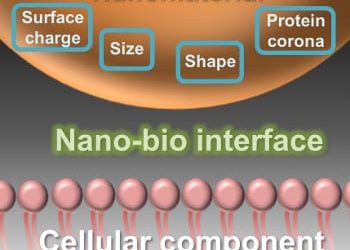 Over the past 6 months, I have had the pleasure of working on several manuscripts from the research group of David Tai Leong, who stood out initially for his enthusiasm and his particularly friendly and polite manner.
Over the past 6 months, I have had the pleasure of working on several manuscripts from the research group of David Tai Leong, who stood out initially for his enthusiasm and his particularly friendly and polite manner.
I was introduced to his work through a feature article in Advanced Functional Materials on nanomaterials for biomedical applications. Since then, I have discovered that the Assistant Professor in Chemical and Biomolecular Engineering, whose laboratory is based at the National University of Singapore, has been the co-author of countless papers spanning stem cell research, cellular and bio-engineering, nanotoxicology and nanobiology, including many papers listed as Highly Cited by the ISI Citations service.
“Welcome to our world of Nano-biology and New Biomaterials”, his group home page invites us. I asked Dr. Leong if he would mind answering a few questions about that world, and here are his responses:
CONCERNING YOURSELF AND YOUR HABITS
I believe that you’ve spent most of your academic life in Singapore. Did you grow up there?
Yes, I spent most of my life in this small red dot called “Singapore”.
Where is your favourite place to just think?
Staring hypnotically at the black line at the bottom of a swimming pool, swimming.
Please describe your desk – is it perfectly organised, totally chaotic, or something in between?
It is perfectly chaotic. Anything less than perfect chaos would make it impossible to find anything on my desk.
When you have time off work, what do you enjoy doing?
1. Spending time with my family. 2. Swimming
Who was the last person that you took a photograph of?
My kids.
CONCERNING YOUR CAREER AND RESEARCH
Since 2010, you have focussed on discovering the novel biological effects of nanomaterials and solving their mechanisms, and some of these papers have been very highly cited for several years running. Why is this work important?
Nanomaterials’ humongous impact on life is an understatement. There are implications to human and environmental health regardless of the original intended use of the nanomaterial. Therefore, understanding the biological impact of these often new materials is important in trying to maximize their efficacy (for nanomedicine) or minimize their danger (nanosafety).
We have made our little contributions in that we have discovered two new mechanisms of nanomaterials. The first is what we describe as ‘nanoparticle-induced endothelial cell leakiness (NanoEL)’. We found that nanoparticles find their way into the spaces between endothelial cells, and disrupt the all-important cell–cell contact. This can lead to dangers like increased metastasis or exploitable opportunities for increased accessibility to tumors. Our second contribution is where we showed that nanoparticles have the ability to drastically inhibit cell migration through directly affecting cytoskeletal machinery and cell traction. This implies that nanomaterials may affect important biological processes like skin wound healing and fetal developmental processes, which require orchestrated cellular migration. At the same time, there is the possibility of using nanomaterials as anti-metastasis agents.
We are also working on developing more biomimetic cell-culture systems that better represent the “real” in-vivo environment in vitro, without going into the animal. We are constantly on the look-out for interesting and important phenomena, and we try our best to come out with hypotheses and design elegant experiments to prove or disprove them. We believe that there is a need to move away from the mere characterization of effects and into the realm of understanding. It is through this understanding that the re-engineering of nanomaterials to increase or decrease a specific biological effect will be allowed.
What other major studies are currently going on in your lab?
We have spent the past three to four years figuring out the mechanisms from the cell’s perspective. Now we are trying to figure out the nanomaterial’s contributions to a given phenomenon. The logic is very simple. We can’t really control the cell’s response; what we can control is how we engineer our nanomaterials.
On a related note, we have recently, in 2013, started working on DNA nanostructures for various diagnostic and drug-delivery applications. We were very humbly encouraged by the responses from the field with our initial papers in this domain.
You started out studying chemical engineering, then completed a PhD in biology. Was there a particular moment, or a specific research question, that drew you toward studying biological systems?
Yes, I started out wanting to use stem cells to tissue engineer a heart valve, because I had a heart condition. Thereafter the interest in biology and engineering took on a life of its own.
You have worked at the Howard Hughes Medical Institute. What was your time in America like, both personally and professionally?
It was absolutely a life-changing experience. I experienced first hand a depth of passion and curiosity for science. For that, I am always grateful to my mentor, Professor Morris Jay Birnbaum. In many ways, I try to replicate that experience in my research group at National University of Singapore.
You also have a Diploma of Education. Do you take regular classes, and do you enjoy teaching?
Yes, I love teaching and interacting with undergraduate and graduate students. I teach an undergraduate Engineering Statistics course and a graduate level module on the biological effects of nanomaterials.
As a scientist and author, would you like to comment on the current state and future directions of scientific publishing?
The current state is generally healthy, though authors (and reviewers) always need to steer away from the predatory journals. It also appears that open access journals are gaining popularity. The market forces should bring down the cost of publishing as journals start to enjoy more efficient economies of scale.
Do you have any work in particular that you feel is very close to actual application, or that has already been applied?
At this stage, we are still quite a distance from any real-world application, but that is definitely one of the key directions we are actively working towards. The environment in Singapore and in NUS is highly conducive for both translational (and fundamental) work, and we are working with local and international researchers who are at the top of their respective fields, to push toward those outcomes.
AND FINALLY…
If you could give new undergraduate students one piece of advice on their first day, what would you tell them?
Take the risk and go for the path less travelled.













